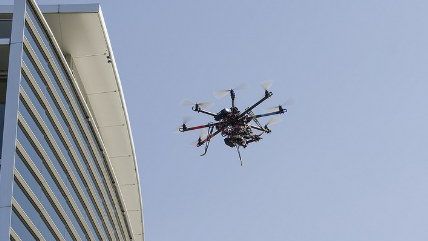Commercial Drone Delivery Guidelines Start Taking Shape
When does the taco copter arrive?


America saw the first formal, government-authorized commercial delivery via drones (or unmanned aerial vehicles—UAVs) over the summer. A small drone by an Australian startup named Flirtey, in conjunction with several government and academic institutions, brought some medical supplies to a rural health clinic in Virginia last July.
The Federal Aviation Administration (FAA) has been bigfooting all over attempts to innovate commercial drone use, banning them entirely while it attempts to (very, very slowly) craft regulations to oversee a system. The most recent news was that they have attempted to implement a comically broad mandatory registration system for all UAVs, commercial or private, weighing more than half a pound.
But now we're seeing some pulling back on the handbrakes. The FAA has announced a little bit of loosening up. The agency has just decided to double the height of the flight ceiling for UAVs from 200 feet to 400 feet anywhere in the country as long as there aren't other restrictions in place (like restricted airspace or in major cities). Keep in mind, though, the FAA's rule that drones have to remain in visual view of its pilot will still apply. The FAA also made it easier for commercial drone users to register their vehicles online cheaply.
We're also now seeing what sort of recommendations are coming out of the committee the government put together to establish more formal uses for commercial drones. The Associated Press got a copy of the recommendations that were sent to the FAA on Friday, though the FAA isn't actually obligated to implement the rules. The recommendations would create four categories of UAV guidelines, according to the AP:
The first category of drones would weigh no more than about a half-pound. They essentially could fly unrestricted over people, including crowds. Drone makers would have to certify that if the drone hit someone, there would be no more than a 1 percent chance that the maximum force of the impact would cause a serious injury. …
Drones in the second category are expected to be mostly small quadcopters — drones with multiple arms and propellers, and weighing 4 pounds to 5 pounds — but there is no weight limit. Flights over people, including crowds, would depend on the design and operating instructions. Manufacturers would have to demonstrate through testing that the chance of a serious injury was 1 percent or less.
Drones in the third category could not fly over crowds or densely populated areas. These drones would be used for work in closed or restricted sites where the people that the drones fly over have permission from the drone operator to be present. Those people would be incidental to the drone operations and flights over them would be brief, rather than sustained. Manufacturers would have to show there was a 30 percent chance or less that a person would be seriously injured if struck by the drone at the maximum strength impact possible.
Drones in the fourth category could have sustained flights over crowds. Working with the FAA and engaging the local community, the operator would have to develop a "congested area plan" showing how flight risks would be mitigated. As before, the risk of serious injury would have to be 30 percent or less. Safety tests would be more exacting and the FAA would set a limit on how strong the drone's maximum impact could be.
According to the AP, the Air Line Pilots Association and trade associations for helicopters and crop dusters attempted to protect their turf by trying to force drone pilots pass a test administered by the FAA and get a background check. This is protectionism via licensing, a method by which entrenched businesses and workers groups attempt to stave off competition by making it harder (often unnecessarily so) to participate in the industry. They did not get their way, but they apparently were permitted to include a dissent in the recommendations.
Show Comments (187)